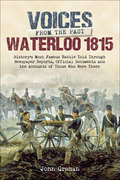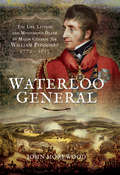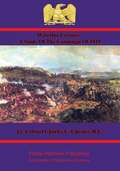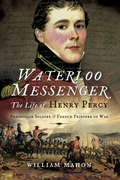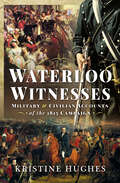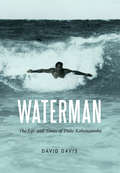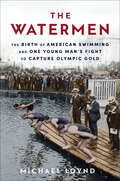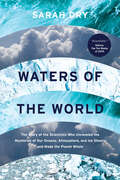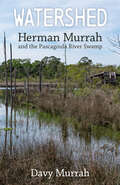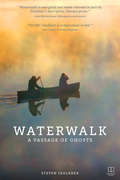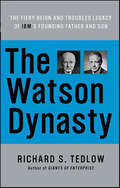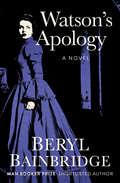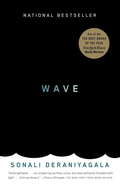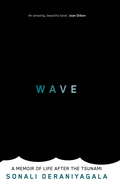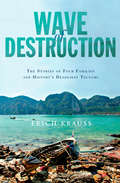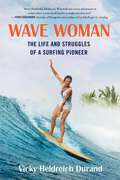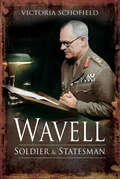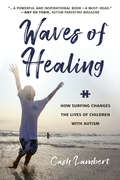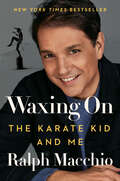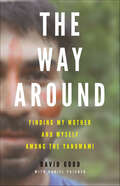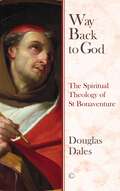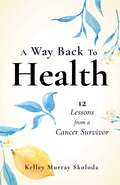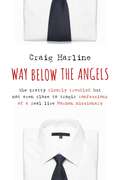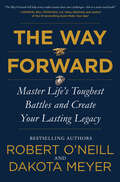- Table View
- List View
Waterloo 1815: History's Most Famous Battle Told Through Newspaper Reports, Official Documents and the Accounts of Those Who Were There (Voices from the Past)
by John GrehanFor more than twenty years Europe had been torn apart by war. Dynasties had crumbled, new states had been created and a generation had lost its young men. When it seemed that peace might at last settle across Europe, terrible news was received Napoleon had escaped from exile and was marching upon Paris. Europe braced itself once again for war. The allied nations agreed to combine against Napoleon and in May 1815 they began to mass on France's frontiers. The scene was set for the greatest battle the world had yet seen.Composed of more than 300 eyewitness accounts, official documents, parliamentary debates and newspaper reports, Voices from the Past tells the story of Napoleon's last battles as they were experienced and reported by the men and women involved. Heroic cavalry charges, devastating artillery bombardments, terrible injuries, heart-breaking encounters, and amusing anecdotes, written by aristocratic officers and humble privates alike, fill the pages of this ambitious publication. Many of these reports have not been reproduced for almost 200 years.
Waterloo General: The Life, Letters and Mysterious Death of Major General Sir William Ponsonby, 1772–1815
by John MorewoodThe defeat of Napoleons French army by the combined forces of Wellington and Blcher at Waterloo on 18 June 1815 was a turning point in world history. This was the climax of the Napoleonic Wars, and the outcome had a major influence on the shape of Europe for the next century and beyond. The battle was a milestone, and it cannot be properly understood without a detailed, on-the-ground study of the landscape in which it was fought and that is the purpose of David Butterys new battlefield guide. In vivid detail, using eyewitness accounts and an intimate knowledge of the terrain, he reconstructs Waterloo and he takes the reader and the visitor across the battleground as it is today. He focuses on the pivotal episodes in the fighting the day-long struggle for the chateau at Hougoumont, the massive French infantry assaults, repeated cavalry charges, the fall of La Haye Sainte, the violent clashes in the village of Plancenoit, the repulse of the Imperial Guard and rout of the French army. This thoroughgoing, lucid, easy-to-follow guide will be a fascinating introduction for anyone who seeks to understand what happened on that momentous day, and it will be an essential companion for anyone who explores the battlefield in Belgium.
Waterloo Lectures: A Study Of The Campaign Of 1815
by Lt.-Colonel Charles C. Chesney R.E.This ebook is purpose built and is proof-read and re-type set from the original to provide an outstanding experience of reflowing text for an ebook reader. Waterloo Illustration Pack - 14 maps/battle plans, 18 portraits of the personalities engaged, 10 illustrations. The Waterloo campaign of 1815 was a turning point in world history. After 25 years of almost constant warfare that raged from India to Canada, from South America to the Caribbean, peace among the European powers was decided on a small strip of land in modern day Belgium. The momentous fruits of the campaign have led to the decisions and actions of the belligerents and their armies to be argued back and forth ever since. Colonel Chesney's work is amongst a handful of books that are considered to be "standard" as histories of the campaign that have been translated into French and German. It is fitting that the work of such a learned soldier, who is also a late professor of Military Art and History at the Staff College in Camberley, should be such a balanced and detailed account of the campaign. This ebook is based on the 4th edition which includes all of the changes that Colonel Chesney wished to be incorporated until his untimely death and was published posthumously. Title - Waterloo Lectures: A Study Of The Campaign Of 1815 (4th Edition) Author -- Lt.-Colonel Charles C. Chesney R.E. (1826-1876) Text taken, whole and complete, from the edition published in 1907, London, by Longmans, Green and Co. Original - xiv and 251 pages. Illustrations - The original map cannot be provided with this edition due to its A3 size - We have added our Waterloo Illustration pack to ensure that the reader can follow the text.
Waterloo Messenger: The Life of Henry Percy: Peninsular Soldier & French Prisoner of War
by William MahonAt the Battle of Waterloo Sir William Ponsonby, a man who the Duke of Wellington stated had rendered very brilliant and important services and was an ornament to his profession, was killed by French lancers after leading the Union Brigade (the three Dragoon Regiments of the Royals, Iniskillings and Scots Greys) in a charge that wrecked a French advance that threatened Wellington with defeat. Sir William was a career soldier who had led his regiment in the decisive charge at the Battle of Salamanca and served with great distinction during the Peninsular War. Yet historians have blamed him because the charge at Waterloo got out of hand. In this book John Morewood uses family sources, including Sir Williams letters, as well as French and German accounts, to restore his reputation and, by shedding new light on the battle, establishes what really happen to him on that fatal afternoon. It is also a biography of a man whose bravery and professionalism distinguished him as one of the outstanding cavalry commanders of the age.
Waterloo Witnesses: Military and Civilian Accounts of the 1815 Campaign
by Kristine HughesThe events of Sunday, 18 June, stand as the defining moment of the year 1815, if not of an entire era. The allied victory over Napoleon’s French army at the Battle of Waterloo reshaped governments and boundaries, made or broke fortunes and touched thousands of lives in ways both large and small, and it has been analysed, dissected and refought on paper a hundred times. Perhaps, though, the very best words ever written about that momentous campaign are the first-person accounts recorded as events unfolded. It is these vivid accounts that Kristine Hughes has collected together in order to convey the hopes, fears and aspirations of their authors. They inject the story of the battle with a level of humanity that reclaims it from the realm of legend and restores it to the people who witnessed it. In chronological order her work pieces together a novel view of the battle and events surrounding it as they were experienced by both military men and civilians. The result is a fascinating and varied picture of the individuals involved and the society of the period. Their words make compelling reading.
Waterman: The Life and Times of Duke Kahanamoku
by David DavisWaterman is the first comprehensive biography of Duke Kahanamoku (1890–1968): swimmer, surfer, Olympic gold medalist, Hawaiian icon, waterman.Long before Michael Phelps and Mark Spitz made their splashes in the pool, Kahanamoku emerged from the backwaters of Waikiki to become America’s first superstar Olympic swimmer. The original “human fish” set dozens of world records and topped the world rankings for more than a decade; his rivalry with Johnny Weissmuller transformed competitive swimming from an insignificant sideshow into a headliner event.Kahanamoku used his Olympic renown to introduce the sport of “surf-riding,” an activity unknown beyond the Hawaiian Islands, to the world. Standing proudly on his traditional wooden longboard, he spread surfing from Australia to the Hollywood crowd in California to New Jersey. No American athlete has influenced two sports as profoundly as Kahanamoku did, and yet he remains an enigmatic and underappreciated figure: a dark-skinned Pacific Islander who encountered and overcame racism and ignorance long before the likes of Joe Louis, Jesse Owens, and Jackie Robinson.Kahanamoku’s connection to his homeland was equally important. He was born when Hawaii was an independent kingdom; he served as the sheriff of Honolulu during Pearl Harbor and World War II and as a globetrotting “Ambassador of Aloha” afterward; he died not long after Hawaii attained statehood. As one sportswriter put it, Duke was “Babe Ruth and Jack Dempsey combined down here.”In Waterman, award-winning journalist David Davis examines the remarkable life of Duke Kahanamoku, in and out of the water.
The Watermen: The Birth of American Swimming and One Young Man's Fight to Capture Olympic Gold
by Michael LoyndThe feel-good underdog story of &“one of the most fascinating people not only in the sport of swimming but in all of athletics&” (Olympic gold medalist Rowdy Gaines): the first American swimmer to win Olympic gold, set against the turbulent rebirth of the modern Games—for fans of The Boys in the Boat and Seabiscuit&“A truly compelling story of athletic triumph, individual perseverance in the face of adversity, and significant social history.&”—Bob Costas, former NBC host of twelve Olympic GamesIn the early twentieth century, few Americans knew how to swim, and swimming as a competitive sport was almost unheard of. That is, until Charles Daniels took to the water.On the surface, young Charles had it all: high-society parents, a place at an exclusive New York City prep school, summer vacations in the Adirondacks. But the scrawny teenager suffered from extreme anxiety thanks to a sadistic father who mired the family in bankruptcy and scandal before abandoning Charles and his mother altogether. Charles&’s only source of joy was swimming. But with no one to teach him, he struggled with technique—until he caught the eye of two immigrant coaches hell-bent on building a U.S. swim program that could rival the British Empire&’s seventy-year domination of the sport.Interwoven with the story of Charles&’s efforts to overcome his family&’s disgrace is the compelling history of the struggle to establish the modern Olympics in an era when competitive sports were still in their infancy. When the powerful British Empire finally legitimized the Games by hosting the fourth Olympiad in 1908, Charles&’s hard-fought rise climaxed in a gold-medal race where British judges prepared a trap to ensure the American upstart&’s defeat.Set in the early days of a rapidly changing twentieth century, The Watermen—a term used at the time to describe men skilled in water sports—tells an engrossing story of grit, of the growth of a major new sport in which Americans would prevail, and of a young man&’s determination to excel.
Waters of the World: The Story of the Scientists Who Unraveled the Mysteries of Our Oceans, Atmosphere, and Ice Sheets and Made the Planet Whole
by Sarah DryA Nature Top Ten Book of the Year: “Immensely readable” accounts of seven pioneers who were at the forefront of what we now call climate science (New York Review of Books).One of Booklist’s Top Ten Sci-Tech Books of the YearFrom the glaciers of the Alps to the towering cumulonimbus clouds of the Caribbean and the unexpectedly chaotic flows of the North Atlantic, Waters of the World is a tour through 150 years of the history of a significant but underappreciated idea: that the Earth has a global climate system made up of interconnected parts, constantly changing on all scales of both time and space. A prerequisite for the discovery of global warming and climate change, this idea was forged by scientists studying water in its myriad forms. This is their story.Linking the history of the planet with the lives of those who studied it, Sarah Dry follows the remarkable scientists who summited volcanic peaks to peer through an atmosphere’s worth of water vapor, cored mile-thick ice sheets to uncover the Earth’s ancient climate history, and flew inside storm clouds to understand how small changes in energy can produce both massive storms and the general circulation of the Earth’s atmosphere. Each toiled on his or her own corner of the planetary puzzle. Gradually, their cumulative discoveries coalesced into a unified working theory of our planet’s climate.We now call this field climate science, and in recent years it has provoked great passions, anxieties, and warnings. But no less than the object of its study, the science of water and climate is—and always has been—evolving. By revealing the complexity of this history, Waters of the World delivers a better understanding of our planet’s climate at a time when we need it the most.“One of the richest books I have ever read . . . a beautifully written, episodic, yet comprehensive, history of the diverse scientific underpinnings of climate science over the past two hundred years.” —Environmental History“Smart, compelling, and timely . . . By focusing on specific scientists, Dry gifts readers with entertaining portraits of some thoroughly interesting if largely unknown individuals.”—Booklist (starred review)
Watershed: Attending to Body and Earth in Distress
by Ranae Lenor HansonA personal health crisis, stories from environmental refugees, and our climate in danger prompt a meditation on intimate connections between the health of the body and the health of the ecosystem The body of the earth, beset by a climate in crisis, experiences drought much like the human body experiences thirst, as Ranae Lenor Hanson&’s body did as a warning sign of the disease that would change her life: Type 1 diabetes. What if we tended to an ailing ecosystem just as Hanson learned to care for herself in the throes of a chronic medical condition. This is the possibility explored in a work that is at once a memoir of illness and health, a contemplation of the surrounding natural world in distress, and a reflection on the ways these come together in personal, local, and global opportunities for healing.Beginning with memories from a childhood nurtured among the waters of Minnesota, Watershed follows the streams and tributaries that connect us to our world and to each other, as revealed in the life stories of Hanson&’s students, Minnesotans driven from their faraway homelands by climate disruption. The book&’s currents carry us to threatened mangrove swamps in Saudi Arabia, to drought-stricken Ethiopia, to rocks bearing ancient messages above crooked rivers in northern Minnesota, to a diabetic crisis in an ICU bed at a St. Paul hospital. With the benefit of gentle insight and a broad worldview, Hanson encourages us at every turn to find our own way, to discover how the health of our bodies and the health of the world they inhabit are inextricably linked and how attending, and tending, to their shared distress can lead to a genuine, grounded wellbeing. When, in the grip of a global pandemic, humans drastically change their behavior to preserve human life, we also see how the earth breathes more freely as a result. In light of that lesson, Watershed helps us to consider our place and our part in the health and healing of the world around us.
Watershed: Herman Murrah and the Pascagoula River Swamp
by Davy MurrahThe Pascagoula River is the largest unobstructed river in the contiguous United States. Because of this lack of restraint, the river has been left to rise and fall naturally with the seasons, overflowing annually into the adjoining bottomland forest. This phenomenon makes the Pascagoula River one of the wildest rivers, surrounded by some of the most ecologically diverse woodlands, in North America.Herman Murrah (1935–2002) lived his entire life on the banks and in the swamp surrounding this river in southeast Mississippi. Watershed: Herman Murrah and the Pascagoula River Swamp recounts pivotal moments in Herman’s life and in Mississippi’s conservation history more broadly. In this book, Herman’s eldest son, Davy, details the adventures that continue to inspire young conservationists in the fight to protect our remaining natural ecosystems.As a young adult, Herman worked as a game warden in the Pascagoula River Swamp. When the Pascagoula Hardwood Company, then owners of the swamp, decided to sell the vast tract of forest for clearcutting, Herman was incensed. Determined to protect this natural wonder, Herman teamed up with other visionaries to persuade the State of Mississippi to purchase the land and preserve it in perpetuity to the benefit of future generations of humans and wildlife alike. Eventually, the state agreed and finalized the purchase. Herman was appointed area manager for the upper portion of the newly designated Pascagoula River Wildlife Management Area. He dedicated the remainder of his life to preserving, protecting, and improving the swamp for the good of south Mississippi.
Waterwalk: A Passage Of Ghosts
by Steven FaulknerSteven Faulkner and his 16-year-old son Justin are paddling and portaging their way along the 1000-mile, 1673, Mississippi discovery route of French explorers Marquette and Joliet. Tired, hungry, lost, lonely, fogbound, canoe-wrecked, unable to make their way in the darkness, they are having an excellent time—paddling 300 miles along Lake Michigan’s shore to Green Bay, Wisconsin, then 300 miles up the storm-flooded Fox River, down the Wisconsin River, then turning south for 400 miles down the mighty Mississippi to St. Louis. Waterwalk is a triple journey: a journey into the heart of this continent 300 years ago—as depicted in Marquette’s own journal (a translation of which Faulkner found in the basement of a University of Kansas library), a modern exploration of the quiet waterways that weave their way through busy, rush-around America, and a voyage through the heart of a father-son relationship.“Something in us,” says Faulkner, “longs to go the way of the river, to lie down on those silken currents and swing away from the bank and move along mile after mile. There’s something there that’s wild and strong and asleep in mystery . . .And all the while, rivers spoke to us in unfamiliar languages, the winds warned us of unheeded perils, statues came alive and shared their stories, and a father and son tried to learn the language of friendship and interdependence."
The Watson Dynasty: The Fiery Reign and Troubled Legacy of IBM's Founding Father and Son
by Richard S. TedlowThis account of IBM’s famed father-and-son CEOs and the family conflicts behind the scenes is “a revealing look at the making of corporate America” (Publishers Weekly).For an extraordinary fifty-seven-year period, one of the nation's largest and fastest-growing companies was run by two men who were flesh and blood. The chief executives of the International Business Machines Corporation from 1914 until 1971 were Thomas J. Watson, Sr. and Thomas J. Watson, Jr., and that great corporation bears the imprint of both men’s ambitions and strengths—but it also bears the consequences of a family that was in near-constant conflict.Sometimes wrong but never in doubt, both Watsons had clear and farsighted visions of what their company could become. They also had volcanic tempers. Their fights with each other combined with their commitment to leadership and excellence made IBM one of the most rewarding yet gut-clutching firms to work for in the history of American business.Our expectations of professional behavior include leaving emotions and vulnerabilities at home each day. In the case of the Watsons, filial and sibling strife could not be excluded from the office. In closely studying the desires and frustrations of the Watson family, eminent historian Richard S. Tedlow has produced something more than a family portrait or a company history. He delves into the role of emotion in corporate life, and explores the interplay between the personalities of these two extraordinary men and the firm they created. Both Watsons had deeply held beliefs about what a corporation is and should be. These ideas helped make “Big Blue” the bluest of blue-chip stocks during their long tenure. These very beliefs, however, also sowed the seeds for IBM’s disasters in the late 1980s and early 1990s, when the company had lost sight of the original meaning behind many of the practices each man put into place. Tracing the family’s idiosyncratic ability to cope with each other’s weaknesses but not their strengths, The Watson Dynasty is a “highly readable” portrait of a towering pioneer of the technology industry and the father and son who built it (Library Journal).“Crisp, engaging.” —Enterprise & Society
Watson's Apology: A Novel
by Beryl BainbridgeA novel of marital bickering--and murder--based on a historical case in Victorian England, from the bestselling author of The Birthday Boys. In the winter of 1884, John Selby Watson, a clergyman and headmaster living in London, writes a series of love letters--including a marriage proposal--to a woman he met only briefly at a social gathering many years before. Though Anne Armstrong does not remember Watson, she is desperate to escape poverty and the miserable life she shares with her sister in a moldy Dublin boarding house. So she accepts. Despite the abrupt circumstances of their engagement--and Anne's initial distaste for her betrothed--several years of happy marriage follow. But Watson soon becomes entrenched in his studies of classical literature, leaving his wife feeling alienated and dejected. Trivial disputes agitate the couple's domestic life with increasing frequency--a letter goes missing, the page of a book gets stained--until the bickering erupts into full-blown abuse and, during a night of drinking, their toxic environment reaches its destructive climax. Based on a real nineteenth-century murder case, Watson's Apology is a speculative novel about the complex psychological motivations that underlie a seemingly straightforward domestic tragedy. Using dark irony and twisted humor, award-winning British author Beryl Bainbridge reveals the terror that resides in the banal, and the suspense that can be found in the mysteries of the mind and heart.
Wave
by Sonali DeraniyagalaOn the morning of December 26, 2004, on the southern coast of Sri Lanka, Sonali Deraniyagala lost her parents, her husband, and her two young sons in the tsunami she miraculously survived. In this brave and searingly frank memoir, she describes those first horrifying moments and her long journey since. She has written an engrossing, unsentimental, beautifully poised account: as she struggles through the first months following the tragedy, furiously clenched against a reality that she cannot face and cannot deny; and then, over the ensuing years, as she emerges reluctantly, slowly allowing her memory to take her back through the rich and joyous life she's mourning, from her family's home in London, to the birth of her children, to the year she met her English husband at Cambridge, to her childhood in Colombo; all the while learning the difficult balance between the almost unbearable reminders of her loss and the need to keep her family, somehow, still alive within her.
Wave: A Memoir of Life After the Tsunami
by Sonali DeraniyagalaThe book opens and we are inside the wave: thirty feet high, moving at twenty-five mph, racing two miles inland. And from there into the depths of the author's despair: how to live now that her life has been undone? Sonali Deraniyagala tells her story - the loss of her two boys, her husband, and her parents - without artifice or sentimentality. In the stark language of unfathomable sorrow, anger, and guilt: she struggles through the first months following the tragedy -- someone always at her side to prevent her from harming herself, her whole being furiously clenched against the reality she can't face; and then reluctantly emerging and, over the ensuing years, slowly allowing her memory to function again. Then she goes back through the rich and joyous life she's mourning, from her family's home in London, to the birth of her children, to the year she met her English husband at Cambridge, to her childhood in Colombo while learning the balance between the almost unbearable reminders of her loss and her fundamental need to keep her family, somehow, still with her.
Wave of Destruction: The Stories of Four Families and History's Deadliest Tsunami
by Erich KraussThis exquisitely written book puts a human face on the tragedy of 2004's Southeast Asian tsunami through the heartbreaking and heroic stories of four who survived this cataclysmic natural disaster.Erich Krauss arrived in the Thai village of Nam Keam on a relief truck 12 days after an underwater earthquake of unimaginable magnitude erupted across the ocean floor and unleashed a tsunami that destroyed millions of lives and decimated the coastline of Southeast Asia. Wandering around the wreckage in a contamination suit, trying to deliver food and water, he found survivors desperate to tell him what their village had been like and how their lives had been changed forever. In Wave of Destruction, Krauss shares the pain and privation of four villagers who made it through alive only to bury their family and friends.Beginning with their fight for life as a 40-foot wave crashed down upon their community, and ending with their slow, confusing quest to rebuild after the last of the bodies had been buried, Krauss unveils the actions and thoughts of ordinary people who were forced to brave extraordinary circumstances. Krauss, a gifted writer and expert in Thai culture, allows the reader to experience one of the worst disasters the world has ever known—through the eyes of those who will never be able to forget.
Wave Woman: The Life and Struggles of a Surfing Pioneer
by Victoria Heldreich DurandWave Woman is the untold story of an adventurer whose zest for life and learning kept her alive for ninety-eight years. Betty Pembroke Heldreich Winstedt was the granddaughter of Mormon pioneers who, after spending an active and athletic childhood in Salt Lake City, moved to Santa Monica with her family and enrolled at USC to study dental hygiene. Betty went on to elope with a man she hardly knew, and to have two daughters. In middle age, Betty finally followed her dream of living near the ocean; she moved to Hawaii and, at age forty-one, took up surfing. She lived and surfed at Waikiki during the golden years of the mid-1950s and was a pioneer surfer at Makaha Beach. She was competitive in early big-wave surfing championships and was among the first women to compete in Lima, Peru, where she won first place. Betty was an Olympic hopeful, a pilot, a mother, a sculptor, a jeweler, a builder, a fisherwoman, an ATV rider, and a potter who lived life her way, dealing with adversity and heartache on her own stoic terms. A love letter from a daughter to her larger-than-life mother, Wave Woman will speak to any woman searching for self-confidence, fulfillment, and happiness.
Wavell: Soldier and Statesman
by Victoria SchofieldArchibald Wavells life and career makes a marvelous subject. Not only did he reach the highest rank (Field Marshal) and become an Earl and Viceroy of India but his character was complex. He joined the Black Watch in 1901. He stood out during the Great War, quickly earning the Military Cross but losing an eye. He was at Versailles in 1918 but between the Wars his career advanced with Brigade and General commands notably in Palestine where he spotted Orde Wingate. By the outbreak of war he was GOC-in-C Middle East. Early successes against the Italians turned into costly failures in Greece and Crete and Wavell lost the confidence of Churchill; their temperaments differed completely. Wavell was sent to India as C-in-C. After Pearl Harbor Wavell was made Supreme Allied Commander for the SW Pacific and bore responsibility for the humiliating loss of Singapore (he quickly recognized that it could not be held). Problems in Burma tested Churchills patience and he was removed from command to be Viceroy and Governor General of India. As civil unrest and demands for independence grew, in 1947 Prime Minister Attlee replaced Wavell with Mountbatten who oversaw Partition. Wavell died in 1950, after a life of huge achievement tempered with many reverses, most of which were not of his making.
Waves of Healing: How Surfing Changes the Lives of Children with Autism
by Cash Lambert“Stand up, up, UP!” is the mantra of Surfers for Autism, an organization that runs surf events for children with autism, providing the opportunity to not only catch waves, but to become part of a supportive surfing community. It is also a message to all those struggling with autism: a message to stand up, no matter how hard it gets. Waves of Healing collects the stories of a group of everyday families who discovered Surfers for Autism in their search for hope, answers, and healing for their children with autism.These are stories about the struggles children with autism face—the struggle to stand on a surfboard, the struggle to communicate, the struggle to make progress in a world which accepts “normal” and rejects all else. But they’re also stories of breakthroughs, of authentic joy and unbridled excitement as they learn to see their world from a whole new perspective—standing tall atop a surfboard, riding a wave all their own.Exploring new avenues of therapy for those with autism, with therapeutic and extraordinary results, Waves of Healing is a snapshot of hope, courage, and human perseverance.
Waxing On: The Karate Kid and Me
by Ralph MacchioSince The Karate Kid first crane-kicked its way into the pop culture stratosphere in June 1984, there hasn’t been a week Ralph Macchio hasn’t heard friendly shouts of “Wax on, wax off” or “Sweep the leg!” Now, with Macchio reprising his role as Daniel LaRusso in the #1 ranked Netflix show Cobra Kai, he is finally ready to look back at this classic movie and give the fans something they’ve long craved. <p><p>The book will be Ralph Macchio’s celebratory reflection on the legacy of The Karate Kid in film, pop culture, and his own life. It will be a comprehensive look at a film that shaped him as much as it influenced the world. Macchio will share an insider's perspective of the untold story behind his starring role—the innocence of the early days, the audition process, and the filmmaking experience—as well as take readers through the birth of some of the film’s most iconic moments. <p><p>Ultimately, the book centers on the film itself, focusing on the reason that the characters and themes have endured in such a powerful way and how these personal experiences have impacted Macchio's life. It will bring readers back to the day they met Daniel LaRusso and Mr. Miyagi for the first time, but will also provide a fascinating lens into how our pasts shape all of us and how the past can come back to enrich one's life in surprising and wonderful ways. <p> <b>New York Times Bestseller</b>
The Way Around: Finding My Mother and Myself Among the Yanomami
by David GoodRooted in two vastly different cultures, a young man struggles to understand himself, find his place in the world, and reconnect with his mother—and her remote tribe in the deepest jungles of the Amazon rainforest—in this powerful memoir that combines adventure, history, and anthropology.“My Yanomami family called me by name. Anyopo-we. What it means, I soon learned, is ‘long way around’: I’d taken the long way around obstacles to be here among my people, back where I started. A twenty-year detour.”For much of his young life, David Good was torn between two vastly different worlds. The son of an American anthropologist and a tribeswoman from a distant part of the Amazon, it took him twenty years to embrace his identity, reunite with the mother who left him when he was six, and claim his heritage.The Way Around is Good’s amazing chronicle of self-discovery. Moving from the wilds of the Amazonian jungle to the paved confines of suburban New Jersey and back, it is the story of his parents, his American scientist-father and his mother who could not fully adapt to the Western lifestyle. Good writes sympathetically about his mother’s abandonment and the deleterious effect it had on his young self; of his rebellious teenage years marked by depression and drinking, and the near-fatal car accident that transformed him and gave him purpose to find a way back to his mother.A compelling tale of recovery and discovery, The Way Around is a poignant, fascinating exploration of what family really means, and the way that the strongest bonds endure, even across decades and worlds.
Way Back to God: The Spiritual Theology of Saint Bonaventure
by Douglas DalesBonaventure was a great pastor and preacher, and also a very effective teacher. His writing shows clarity and conviction, and his authority arose from his profound grasp of Scripture and patristic monastic tradition. The force behind how he wrote sprang from his keen sense of the significance of Francis and Clare and all that flowed from them, not least into his own spiritual life and experience as a person of deep contemplative and mystical prayer. <p><p>Way Back to God is a comprehensive conspectus and study of how Bonaventure taught Christian theology and applied it to spiritual life. It is intended to be a guide through most of his writings (though not as a substitute for reading them). It provides a bridge into his thought, and also a remarkable hand-book of Christian theology in its bearing upon spiritual life. <p><p>Douglas Dales' new work enables Bonaventure's distinctive spiritual theology to be seen as a whole, as well as making his writings, in Latin or English, accessible and attractive.
A Way Back to Health: 12 Lessons from a Cancer Survivor
by Kelley SkolodaKelley Skoloda was the healthiest person she knew—until the day she became a cancer patient. During her first, routine colonoscopy—without having experienced any symptoms—Kelley received a shocking diagnosis: colon cancer. Based on the true story of her subsequent cancer journey, A Way Back to Health reveals how surprising lessons paved the way for her recovery, shares helpful action steps for those who find themselves in a similar situation, and illuminates how personal stories can powerfully motivate and heal. In addition to telling her own story, Kelley also features examples of how other, amazing survivors have learned to manage, survive and thrive in the face of cancer. She also explores how often overlooked actions, such as trusting your instincts, speaking up, getting a second opinion, and watching for miracles, can have a profound impact on recovery—lessons meant to help patients advocate for themselves and help friends, family, and caregivers as they wrestle with cancer and its treatment. Much more prevalent than COVID-19, cancer will affect one in three people directly, and many more indirectly, in their lifetime. A Way Back to Health, with its real-life stories and unexpected lessons, is a helpful and relatable guide to the most important information you need to know about cancer—for the time you need it most.
Way Below the Angels: The Pretty Clearly Troubled But Not Even Close to Tragic Confessions of a Real Live Mormon Missionary
by Craig HarlineWhen Craig Harline set off on his two-year Mormon mission to Belgium in the 1970s, he had big dreams of doing miracles, converting the masses, and coming home a hero. What he found instead was a lot of rain and cold, one-sentence conversations with irritated people, and silly squabbles with fellow missionaries.From being kicked -- literally -- out of someone's home to getting into arguments about what God really wanted from Donny Osmond, Harline faced a range of experiences that nothing, including his own missionary training, had prepared him for. He also found a wealth of friendships with fellow Mormons as well as unconverted locals and, along the way, gained insights that would shape the rest of his life.Part religious history, part coming-of-age story, part witty spiritual memoir, this book takes readers beyond the stereotypical white shirts and name tags to reveal just how unpredictable, funny, and poignant the missionary life can be.
The Way Forward: Master Life's Toughest Battles and Create Your Lasting Legacy
by Robert O'Neill Dakota Meyer“The Way Forward will help every reader master their own challenges—this is a must-read book!” —Admiral Bill McRaven, U.S. Navy (Retired) and author of the #1 New York Times bestseller Make Your BedAmerican Sniper meets Make Your Bed in these life lessons from decorated United States service members and New York Times bestselling authors Robert O’Neill and Dakota Meyer—an in-depth, fearless, and ultimately redemptive account of what it takes to survive and thrive on battlefields from Afghanistan and Iraq to our daily lives, and how the perils of war help us hold onto our humanity.Rob O’Neill and Dakota Meyer are two of the most decorated and recognized US service members: O’Neill killed the world’s most wanted man, Osama bin Laden, and Meyer was the first living Marine to receive the Medal of Honor since the Vietnam War. But beyond their actions and courage in combat, O’Neill and Meyer also have much in common in civilian life: they are both sought-after public speakers, advocates for veterans, and share a non-PC sense of humor. Combining the best of military memoirs and straight-talking self-help, The Way Forward alternates between O’Neill’s and Meyer’s perspectives, looking back with humor at even the darkest war stories, and sharing lessons they learned along the way.The Way Forward presents O’Neill and Meyer’s philosophy in combat and life. This isn’t a book about the glory of war and combat, but one about facing your enemies, some who are flesh and blood and some that are not: Your thoughts. Your doubts. Your boredom and your regrets. From Rob’s dogged repetition at the free throw line of his childhood basketball court to Dakota’s pursuit of EMT and firefighter credentials to aid accident victims, these two American heroes turn their experiences into valuable lessons for every reader. Gritty and down-to-earth, O’Neill and Meyer tell their stories with candor and vulnerability to help readers handle stress, tackle their biggest obstacles, and exceed their expectations of themselves, while keeping life’s battles in perspective with a sense of humor.
